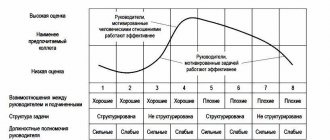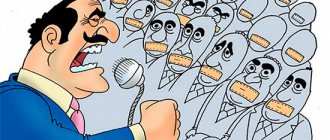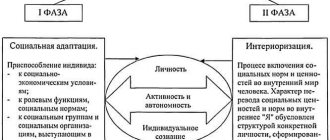1. Basic concepts 2. Democratic leadership style 3. McGregor's theory of democratic leadership
Leaders exist in any organization of people, from an ordinary group of friends to government organizations. Leaders are motivators; the activities of groups largely depend on them. A leader's management style determines his success as a manager.
Manager and leader
What is the difference between two seemingly very similar concepts? To lead is to have the right to make decisions. This feature is not always aimed at instilling authority among the wards. Leadership qualities can be inherent in a person who does not hold a leadership position. This personality is always respected by others. Such a leader is called informal.
People who simultaneously occupy leadership positions and are authoritative leaders succeed best in political activity. A number of qualities indicate the ability to manage. Among them are the following:
- Intelligence.
- Organizational skills.
- Intuition.
- The ability to please the public.
- Willingness to take responsibility.
Political leader through the eyes of Machiavelli
In the work “The Prince” by Niccolò Machiavelli (an Italian philosopher), the requirements for a person who wants to become a successful politician were described in detail. The qualities of a leader in his view look like this:
- Avoid hatred.
- Win people over by instilling trust.
- Create the appearance of virtue in front of the people, regardless of actions.
- Act quickly and firmly if the situation requires it.
- Change your management style based on the situation.
What are leaders like?
In relation to subordinates, managers are divided into authoritarian and democratic. Types of political leadership are class, party and national. Modern political science identifies several collective types. These include the following leaders:
- "Flag Bearer" He is characterized by a special vision and perception of reality. He is also interested in a dream, an ideal that can inspire a large number of people.
- "Servant." He is guided by the needs and demands of his supporters. And his actions are carried out on behalf of voters.
- "Dealer". This type is characterized by the ability to present their ideas attractively. He knows how to convince people that his thoughts and proposals are more tempting than others.
- The “firefighter” acts depending on the situation. He deals with the biggest problems that require immediate action.
Moreover, types of political leadership often have the property of combining these qualities in different proportions. These characteristics are usually not found in their pure form.
Types of DSR, their comparison
Motivating personnel to actively work in the organization - modern methods
Democratic style has two types:
- advisory;
- participative.
Each of them is characterized by its own set of conditions for organizing work.
Advisory
The boss, trusting his employees, consults with his subordinates before making decisions or setting tasks. In the process of such communication, the manager selects the best and most valuable proposals. Based on them, tasks are formed. With this approach, employees receive satisfaction from the fact that they can support their boss and point him in the right direction. As a result, no one is bothered by the fact that instructions come from above. Good offers are usually followed by encouragement.
Advisory type of DSR
Participative
This democratic type of leadership is built on the fact that the boss does not consult, but completely delegates the consideration of assigned tasks to the group, ensuring the involvement of all interested employees for constructive proposals. They are also entrusted with control over the fulfillment of the formed goal.
Participative type of DSR
Charismatic leader
Leaders who captivate and inspire are charismatic. In this case, we can say that the person is gifted. A charismatic leader looks exceptional and infallible in the eyes of others. He seems to be endowed with some kind of supernatural abilities.
People perceive him with reverence and devotion. That is, such a person is a leader who is blindly trusted and followed. However, such faith is not always associated with the right decisions. His words are perceived and remembered because it was this person who expressed them. Charismatic leadership has the ability to unite followers despite danger.
At the same time, it is not easy for such a person to solve current affairs. Moreover, history has many examples of charismatic leaders turning into dictators.
Epilogue
It is impossible to achieve success in politics without being a leader. But achieving success in business without being a leader is quite possible.
You can cultivate a leader within yourself, and your predisposition, natural data and skills will either help you become an outstanding leader or shorten the time of development.
Most mature companies don't need leaders. They may be needed only when it is necessary to move the company to a new stage of development, because the distinctive feature of a leader is that he is not satisfied with the current situation and wants changes.
Democratic leader
The democratic type of leadership, as most researchers believe, is the most preferable. Personalities of this type are respected and intelligent. They are tactful and objective. These qualities manifest themselves when communicating with group members. But such a leader needs much more time to make a decision than an adherent of the authoritarian style. Such a leader listens to the opinions of colleagues and tries to involve people in the formation of decisions. He may disagree with the opinions of his subordinates and, as a result, act in his own way. But such a leader finds it interesting to listen to the opinions of his wards. The fact is that here he is inclined to the possibility of seeing some new solution that could become a fresh trend.
He has nothing against bringing “fresh air” into the organization. Because permanent attitudes tend to become obsolete. Such a leader is able to form new trends based on the opinions of his followers.
From personal experience
The traits of a leader have been noticeable in me since childhood: I either “organized” kids in kindergarten, or boys in the yard. Not a single event took place at school without my participation. I was very worried if I was not chosen as a team leader or captain.
And even when he was out of work, he still tried to command. I tried to be a model for those whose attention and respect I wanted to earn. This is the main feature of leadership.
The desire to lead led to me heading the Komsomol organization and becoming a member of the city and regional committees of the Komsomol. But was this position necessary for career advancement? Looks like no.
The experience gained from working at the head of a Komsomol organization was not only not useful in business, but even got in the way. Having organized the first commercial structure, I hired my friends from the Komsomol cell and gave them the right of first signature. In the end it backfired on me. And all because I was a leader, but I didn’t know how to lead yet.
Authoritarian leader
Adherents of the authoritarian style tend to spend a lot of time instructing. It is common for this type of leadership to tell followers exactly what, how and when to do. The authoritarian type of leadership presupposes the presence of a number of followers over whom they extend their power. At the same time, such leaders do not tend to listen to anyone’s advice or opinions. All decisions in an organization or structure are made by only one person. This person does not encourage others to participate in discussions or express any thoughts or wishes.
Types of leadership assume that such a person introduces a number of attitudes into the structure under his charge that require unconditional submission. It is the complete opposite of the style of behavior discussed above. It is strictly forbidden to ignore the set of rules he proposes. All those who disobey are threatened with certain punishment. It is also undesirable to argue with such a person. He knows perfectly well that the boss is always right, and requires his employees to strictly believe in this attitude.
Advantages and disadvantages
The democratic position of the leader, equally with the authoritarian and liberal positions, has its pros and cons.
Authoritarian leadership style - what is it, advantages and disadvantages
The advantages include the following:
- complete trust in the staff and mutual understanding;
- involving employees in the life of the company;
- team spirit unites and motivates the employee’s independence within the framework of his job responsibilities;
- joint decisions do not cause much dissatisfaction among employees;
- Non-standard approaches allow us to find answers to any given tasks.
The advantages include low staff turnover, job satisfaction and a favorable climate in the organization.
Attention! The decision-making procedure in a democratic leadership style (DSM) occurs at all levels of communication, both vertically (among managers) and horizontally (within the team).
One of the disadvantages of a democratic leadership style is the frequent difficulty in making a common decision and its correctness. In addition, the following can be considered as negative points:
- inability to make quick decisions in emergency situations;
- lack of strict centralization of control;
- emergence of new requirements for management quality.
Improper management of a manager can lead to abuse of freedom and manipulation by subordinates.
The principle of non-interference
Also interesting is a leader whose actions reflect the principle of non-interference. This style is more progressive than democratic. This leader allows subordinates to make decisions freely. Also, wards have complete freedom in performing tasks that are not limited by the instructions of the supervisor.
But all types of leadership assume that the manager bears final responsibility for decisions made. And the principle of non-interference is no exception. Such a person is not characterized by negligence. He has a clear idea of what his ward actually is. Therefore, such a leader knows perfectly what and in what situation to expect from a subordinate. His task is to correctly distribute responsibilities. After this, you can provide the wards with fairly free conditions, as if only slightly controlling them.
Basic Concepts
Definition 1
Leadership is a relationship between people, based on the dominance of one person over others and their subordination, existing to achieve certain goals.
Thus, the main function of a leader is to motivate and set goals to achieve a common result.
The leader performs the function of controlling the psychological atmosphere within the community, so he must have certain skills:
- prevent and resolve conflicts;
- create a positive attitude among group members;
- promote interaction between them.
Did not you find what you were looking for?
Just write and we will help
Another function of a leader is making responsible decisions and defending the interests of the community. For example, the president represents the interests of the entire state, the director represents the interests of the enterprise. The leader is responsible for the distribution of powers among the participants and monitors the implementation of assigned tasks.
Transformational style
Such a leader tends to use his ideas to inspire other people. This personality is characterized by excellent communication skills. That is, such a person speaks quite clearly to his wards. He expresses his thoughts clearly. It’s not difficult with him, because the team of such a person always knows what he wants.
Types of leadership suggest that such a person tends to delegate his own powers to his wards. He spends a lot of time communicating with his team and gets real pleasure from such pastime. The purpose of such meetings is to raise the collective spirit, unite people, and develop in everyone a sense of the importance of involvement in what is happening.
In addition, the leader draws a lot for himself from such conversations. He understands the thinking of the team, its mood, development trends. This leader is also interested in the emotional side of what is happening. If he observes a lack of enthusiasm in someone, he tries to develop interest.
Flexibility
It should be noted that all these types of leadership and management are not perfect. Therefore, the most successful person is called a “flexible leader.” He is able to combine different types of management, guided by the situation. If it is necessary to introduce an authoritarian or democratic style, a flexible leader chooses the most suitable option. This helps achieve the greatest efficiency. And the need for insight and going beyond standard boundaries leads to the choice of a transformational style.
Guided by the proposed specification, it is easy to determine the personal style or type of your leader in the workplace. Knowing the basic characteristics, you can develop the necessary qualities. In this case, you just need to compare the personal characteristics of behavior and the types of leadership described in the article.
What is characteristic of the style of democracy
Personnel management styles - their characteristics, advantages and disadvantages
This method of company management is based on the following characteristic features:
- informing employees about all the company’s affairs, tasks and planned prospects;
- delegation of individual powers and responsibilities to each member of the company, thereby providing the opportunity to demonstrate independence and creativity in the work process;
- psychology of incentive motivation: bonuses, certificates, verbal praise in full view of the entire team, punishments and fines are the exception;
- orientation towards achieving goals;
- in case of low results, they do not look for the culprits, but consider the reasons that need to be eliminated.
Important! The work is organized in such a way that each employee feels like a “gear”, without which the well-oiled mechanism will stop. He sees and understands the entire work process and the share of responsibility that is assigned to him.
However, such a management structure may not work everywhere. Examples where DSR can be used include companies involved in:
- office work;
- using the labor of highly qualified specialists;
- innovative developments.
By the way. In organizations where an employee is required to perform certain work, and his initiative cannot influence the activities of the enterprise as a whole, it is not advisable to use a democratic style.
Teachers at school also cannot use this method of leadership. For example, a physical education teacher cannot be guided by the student’s opinion when accepting a physical training test from him.











